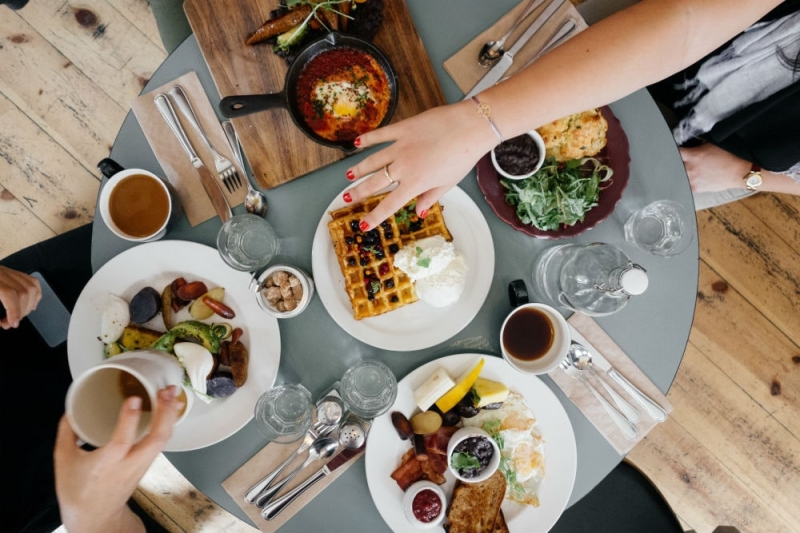
Gastro tourism is becoming increasingly popular. Of course, as part of such a trip you get acquainted with the history and culture of the country not in museums, but in local restaurants and cafes. The journey is not only interesting – the guide tells you about the traditions and characteristics of the region, offering to try certain dishes and wines – but also very tasty. Read below about five cities you should visit for gastronomic pleasures.
Italy, Florence
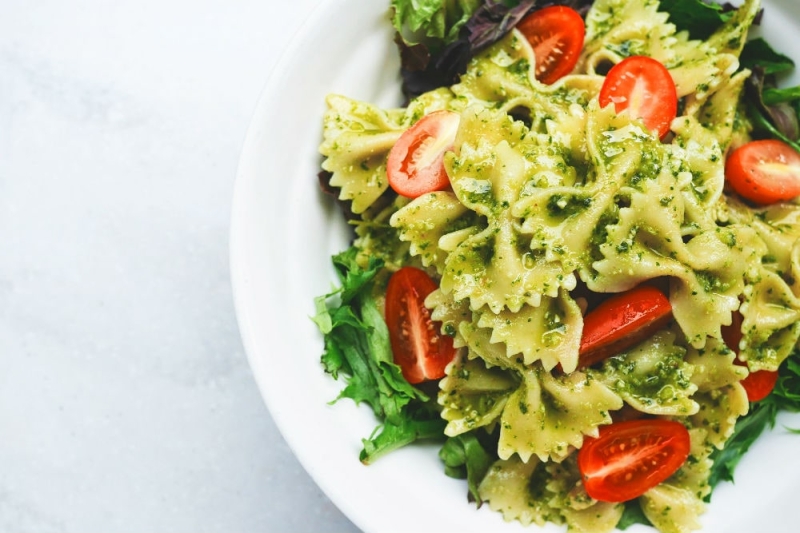
Photo: @eaterscollective
Dinner cost for 1 person: from 30 euros (~2300 rubles)
Italy is a wonderful country for gourmets, but each region has its own characteristics. We recommend starting your acquaintance with Italian cuisine with Tuscany. Here they respect ancient recipes and traditions, while they love simple combinations and simple healthy dishes. Sit down at a small local cafe, ask for fresh bread, dip it in local extra virgin olive oil, and welcome to flavor heaven. Even the olive oil here is unlike what you are used to seeing in stores: it has a greenish tint and an unusual aroma, which is why it is considered one of the best in all of Italy.
In Tuscany you need to try fish dishes, sausages, meat, pasta and vegetable dishes. And, of course, an Italian dinner would be incomplete without wine. It is here that world famous wines are produced and aged: Chianti, Montepulciano, Nobile, Sasicaia, Masseto.
Gastronomic Dictionary
Beefsteak Florentine (bistecca alla fiorentina) – lightly roasted tenderloin from local Chianina breed cows. On average, one steak weighs about a kilogram, the thickness of the piece is 4-5 cm, and the degree of roasting is very weak. The only spices used are salt and olive oil when serving.
Cacciucco is a seafood soup. Historically, they added the fish and seafood that they managed to catch. Today it is believed that a soup should contain at least five varieties of fish – according to the number of letters “c” in the name.
Pappardelle is a type of pasta especially popular in Tuscany. It’s actually a wide noodle. Pappardelle is served with different sauces, one of the most popular is with porcini mushrooms (pappardelle funghi porcini).
Pecorino – sheep’s milk cheese.
Fettunta is a type of bruschetta. Hot bread is rubbed with garlic and seasoned with olive oil, salt and pepper.
Lampredotto – sandwich with offal (cow stomach), the most popular street food.
Ribollita is a thick soup made from legumes, vegetables and bread. A seasonal dish, often served during the cold season.
Prosciutto di cinta senese is a special Tuscan type of prosciutto, a local delicacy. The pigs for this prosciutto are free-ranged in the Siena province. Their meat is not fatty and tastes like wild boar meat.
Cantucci – biscuits with almonds or chocolate. They are served with sweet local wine Vin Santo.
Tuna from Chianti (tonno del chianti) – in Chianti there is no sea, so it is not fish, but pork prepared in a special way. It resembles tuna only in appearance.
Georgia, Tbilisi
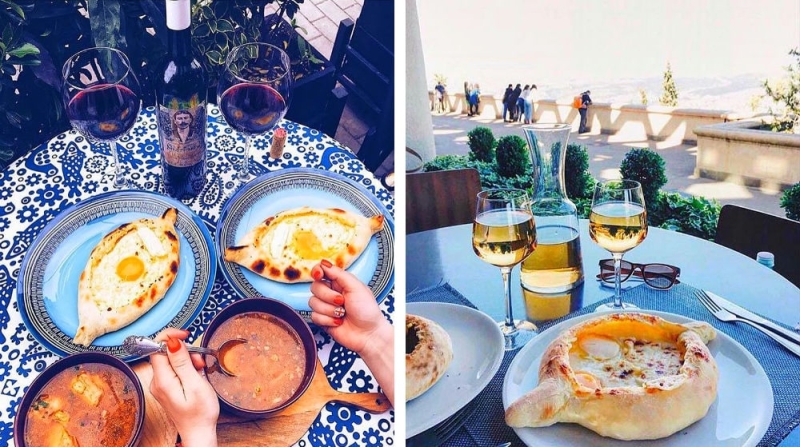
Photo : pa_nika__/georgia_blog/Instagram.com
Dinner cost for 1 person: from 20 lari (~500 rubles)
Georgian cuisine is one of the country’s main attractions, so it is not surprising that the first thing travelers decide is what and where they will eat. Thanks to them, Georgia became a leader among the most popular gastrotourism destinations in 2017. And there is a reason for it: the food here is bright, original and unusually tasty, and the freshest ingredients, unusual sauces and seasonings and fresh herbs are used for cooking.
The emphasis in Georgian cuisine is on meat, sauces and cheeses. And, of course, any meal will be incomplete without Georgian wine – Saperavi, Khvanchkari, Kindzmarauli.

Excursions from local residents in Tbilisi
Gastronomic Dictionary
Pkhali – balls of spinach, beets, cabbage with the addition of walnuts and spices.
Ajapsandal – vegetable stew, prepared from eggplant, tomatoes, sweet peppers, onions, garlic, cilantro, dill and basil. Lobio is a hearty bean dish.
Khachapuri– one of the most famous Georgian dishes. A flatbread with cheese, prepared differently in different parts of the country. Megrelian khachapuri (megruli) is a round flatbread with cheese on top. In Imeretian (imeruli) – round flatbread with cheese inside. In Gurian – crescent-shaped flatbread. Adjarian style – boats with cheese, egg and butter.
Chakhokhbili – stew of tomatoes and poultry (usually chicken).
Satsivi – chicken in a sauce of walnuts, cinnamon and saffron.
Chashushuli – beef stewed with vegetables.
Chakapuli – lamb stew with tarragon.
Khinkali – manti dumplings. They come with different types of meat, cheese or potatoes, with or without herbs. Don’t forget that the dough tail is not eaten.
Kharcho – rich spicy soup that will save you from a hangover.
Churchkhela– a traditional sweet made from walnuts and grape or pomegranate juice.
Pelamushi – thick, hard chilled jelly made from grape juice and corn flour. Served with nuts and kozinaki.
France, Aix-en-Provence
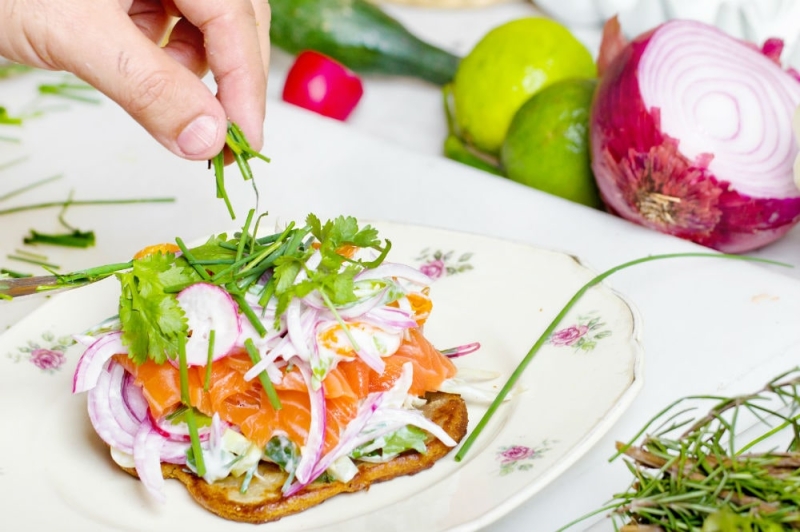
Photo: @monstruoestudio
Dinner cost for 1 person: from 30 euros (~2300 rubles)
The cuisine of Provence is filled with the smells of herbs and fresh fish, it has a lot of vegetables and fruits – no wonder it is called the cuisine of the sun. The cuisine of Provence differs from classical French in its simplicity and down-to-earthness. The dishes made from a variety of vegetables are especially delicious here – just like the world famous ratatouille. It is also worth going here for olives, black olives and olive oil, which are often used in cooking.
Meat is not cooked very often in Provence, and usually these are light options – lamb, rabbit or chicken. But it’s impossible to imagine the cuisine of Provence without wine: be sure to take a bottle of local rosé with dinner.
Gastronomic Dictionary
Ratatouille – traditional vegetable stew, prepared from sweet peppers, eggplant, zucchini and tomatoes with the addition of aromatic herbs and spices.
Bouillabaisse – soup made from fish found off the coast of Marseille, with wine and orange juice. Historically, it was a fisherman’s soup made from all the fish not sold during the day.
Caillettes Pies – round balls of pork liver with spinach or chard and juniper fruits.
Bottargue – pressed dried mullet or tuna caviar.
Banon – soft goat cheese wrapped in dry chestnut leaves, which gives it a special aroma.
Niçoise– famous salad from Nice made from fresh vegetables, boiled eggs, anchovies and olive oil.
French bread fougasse – flatbread with olives, anchovies or lard.
Pissaladière – traditional pizza with olives and anchovies.
Sandwich pan bagnat – French sandwich with Nicoise salad. The bread is soaked in olive oil and tomato juice.
Tapenade (la tapenade) – thick sauce made from olives, anchovies and capers. Serve spread on bread, as a sauce for vegetables, or stuff poultry with it.
Calissons – a traditional sweet made from almonds, candied fruit (usually melon) and orange blossom. Tastes a bit like marzipan.
Israel, Tel Aviv
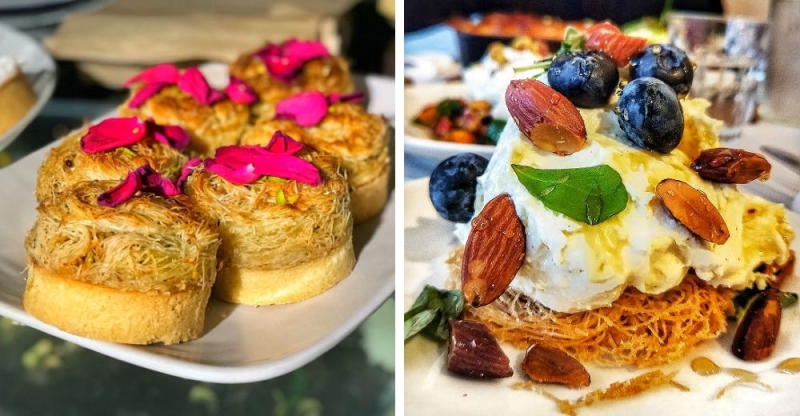
Photo: safoodguru/nomnom_london/Instagram.com
Dinner cost for 1 person: from 100 shekels (~1800 rubles)
Israeli cuisine is rich in flavors and nuances. It is simultaneously similar to the Mediterranean and Arabic, and since many repatriates from different parts of the world returned to the country at one time, everyone will find something to their liking here.
Traditional dishes contain a lot of legumes, vegetables, herbs, olive oil and fruits. On the one hand, these are quite healthy dishes, on the other hand, the Israelis themselves joke that not a single tourist has managed to lose weight here. The fact is that the portions in the cafe are huge, and the dishes are so tasty that it is often simply impossible to stop. And don’t ignore local drinks: you can start your morning with a large glass of freshly squeezed juice or smoothie, and end your evening with a glass of pomegranate wine.

Tours from locals in Tel Aviv
Gastronomic Dictionary
Hummus– a snack widely known outside of Israel. This is a paste made from chickpea puree, tahini (sesame paste), olive oil, garlic, onion, lemon juice and spices.
Falafel is another dish that everyone has heard of at least once. Fried chickpea balls can be eaten alone or in pita with vegetables and hummus.
Cholent (khamin) – hearty roast of meat, potatoes, beans, chickpeas, onions and spices. This dish appeared thanks to Shabbat: according to religious laws, you cannot cook food on Saturday in Israel, so the preparation of cholent begins on Friday: the ingredients are placed in the oven and simmered until Saturday morning.
Shakshuka – a dish of eggs in a spicy sauce of tomatoes, onions and bell peppers. It’s very tasty to eat shakshuka with bread.
St. Peter’s Fish— grilled tilapia with french fries, vegetables and sauce. The name comes from the Bible: this fish was often caught by Peter, who was a fisherman, and it was in its mouth that the apostle found a coin to pay the tax for Jesus.
Knafeh – Arabic sweet made from Kadaif vermicelli and goat cheese. Before serving, pour over sugar syrup and sprinkle with almonds and other nuts.
Bamba – corn sticks soaked in peanut butter.
Burekas – puff pastry pies stuffed with potatoes, vegetables or cheese.
Baba ganoush – eggplant puree with lemon juice and spices, served with fresh bread.
Malauah– an unleavened flatbread made from puff pastry, served with various additives that give it flavor: spicy tomato sauce, boiled eggs, tahini, olive oil, honey, and so on. The dish came from Yemen.
I want to go to Israel!
Denmark, Copenhagen
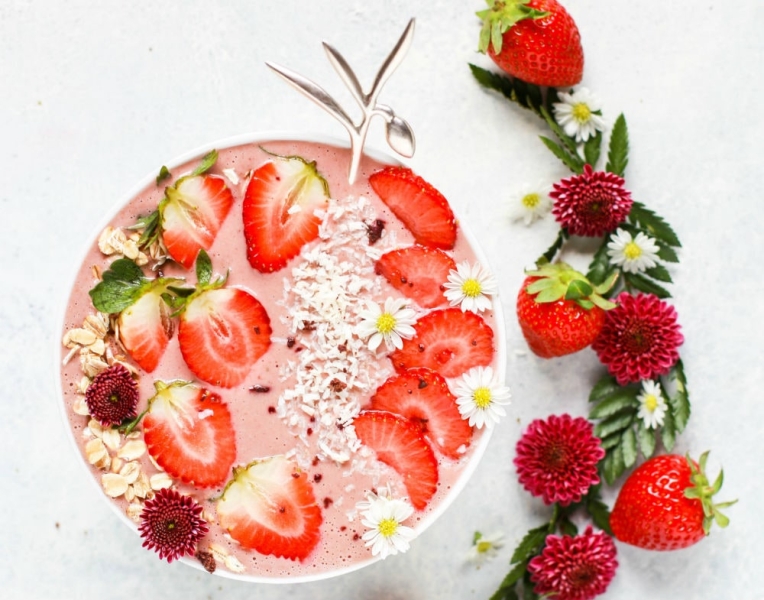
Photo: @cravethebenefits
Lunch cost for 1 person: from 30 euros (~2300 rubles)
Not exactly a traditional destination for gastrotourism – but in vain. If you have already visited most European countries and consider yourself a sophisticated gourmet, go to Scandinavia to try the local cuisine – it will probably surprise you. Danish national food is not like the sunny food of southern France or bright Italian – on the one hand, it is simpler and heavier, on the other, more original and satisfying.
Why you should go to Denmark for Scandinavian food? The fact is that it has absorbed the traditions of almost all the cuisines of the northern countries of Europe. You will find here dishes inspired by German cuisine, as well as almost all the components of Scandinavian cuisine. Danish traditional food contains a lot of meat, vegetable side dishes, cabbage and rich sauces. This is food from cold countries, so it is filling and rich. They also prefer strong alcohol here – liqueurs and vodka, but they also like beer (Carlsberg and Tuborg are Danish brands).
Gastronomic Dictionary
Smørrebrød – famous monumental Danish sandwiches consisting of many ingredients. Pieces of crayfish or crab, fish, meatballs, raw smoked ham, tongue, ham are placed in one or two layers on a slice of rye or white bread… in general, everything that can be found in the kitchen.
Millionbøf – beef, cut into many small pieces, actually minced meat, with gravy. Usually served with mashed potatoes, pasta or rice.
øllebrød – porridge of rye bread soaked overnight in beer, with whipped cream.
ølben – pork ribs marinated in stout and then grilled.
Stegte sild – marinated and fried herring fillet.
Stegt flæsk – a dish of fried bacon, served with potatoes, sour cream sauce with parsley and beets.
Æbleflæsk – meat fried with onions, thyme, sugar and apples.
Rødkål – side dish of red cabbage stewed with apple cider vinegar, sugar and cloves.
Koldskål – a cold summer soup made from buttermilk, egg yolks, vanilla and lemon juice, and added to the resulting mixture whatever you want – for example, rhubarb grated with sugar, fresh strawberries and dry cookies.
rødgrød med fløde – berry pudding with whipped cream. The consistency is similar to a very thick jelly.
Preview photo: @inayali

